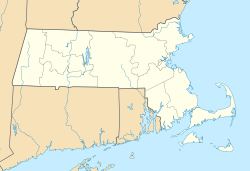| UMLRR | |
|---|---|
 | |
| Operating Institution | University of Massachusetts Lowell |
| Location | Lowell, Massachusetts |
| Coordinates | 42°39′17″N71°19′30″W / 42.65472°N 71.32500°W |
| Type | Pool |
| Power | 860420650 cal(th)/h |
| Construction and Upkeep | |
| Construction Cost | $1.2 million USD |
| Construction Began | 1974 |
| First Criticality | 1975 January 2 |
| Annual Upkeep Cost | $0.3 million USD |
| Staff | 2 |
| Operators | 6 |
| Technical Specifications | |
| Max Thermal Flux | 1.4e13 n/cm^2-s |
| Max Fast Flux | 9.2e12 n/cm^2-s |
| Cooling | light water |
| Neutron Moderator | light water |
| Neutron Reflector | graphite, light water |
| Control Rods | Boron-Aluminium-Carbide (Boral) 4 per element |
| Cladding Material | aluminium alloy |
The Radiation Laboratory at the University of Massachusetts Lowell serves the Department of Applied Physics among others. The laboratory contains the University of Massachusetts Lowell Research Reactor (UMLRR), a 1 MW pool-type research reactor [1] that has been operating since 1974, along with Co-60 gamma ray sources and a 5.5 MeV Van de Graaff accelerator.


